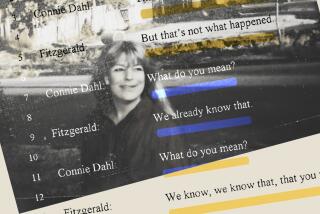Documenting life -- and then death
- Share via
Vanessa Roth studied the girl sitting across the table.
A light smell of deep-frying oil hung in the air of the Carl’s Jr. restaurant, where the girl worked night shifts to save for college. Roth, an independent filmmaker, knew this girl would be perfect for her documentary on foster children aging out of the system. She was looking for at least one child to represent a success story,among the many others who end up pregnant, incarcerated or homeless.
Risa Bejarano seemed to be that child.
Barely 5 feet tall, with a round face and gold streaks in her chocolate-brown hair, Risa was a high school senior whose cheery smile made her seem like any other teenager. Roth picked at her fries and sipped a milkshake as she listened to Risa recount her tragic upbringing, typical of so many of the foster kids Roth had featured in her documentaries: a drug-addict mother, a sexually abusive stepfather, and siblings on drugs, on the streets and in jail. Since age 9, Risa had bounced from home to home.
Now she seemed bound for something very different. She talked about her long list of activities, her honors classes, her plans for the future. She was at the top of her class, working two jobs and on her way to UC Santa Barbara on scholarships. She dreamed of becoming a psychologist or a teacher.
Roth explained to Risa what it would be like to be the subject of a film. She would be asking a lot of the girl by bringing a camera into her life as she transitioned out of foster care. The camera would have to be there, Roth told her, for the good times and the bad.
The girl agreed without hesitation.
Roth filmed a beaming Risa wearing a white dress at her prom, as a proud honor student at her high school graduation, being showered with praise at her emancipation from foster care.
Soon, however, Roth saw glimpses of something else beneath Risa’s strong, articulate front.
The girl confided to the filmmaker that she was experimenting with more drugs to stay up the long hours demanded by schoolwork and jobs. She talked about her past and how much she identified with the world she had come from, and how much she feared being sucked back into it.
College meant new pressures and temptations she wasn’t prepared for. Roth watched her fall behind in her classes and struggle with drug addiction. As a friend, Roth offered some advice and support. But as a documentarian wanting to tell the story as it unfolded, she was careful to leave decisions up to the girl.
Halfway through her second semester at UCSB, Risa suffered a psychological breakdown. Doctors feared she was showing signs of schizophrenia. She left school and moved back in with her foster mother. But she was quickly back on her feet -- starting work, signing up for community college classes and moving into an independent living facility.
Roth’s crew wrapped filming with Risa on a hopeful note. The filmmaker returned to her life with her husband and two young daughters.
The film premiered the following year to acclaim at festivals around the country. Variety said “Aging Out,” by Roth and East Coast director Roger Weisberg, combined “strong human interest and an overlooked social issue.” PBS picked it up for national broadcast.
But as Roth’s film reached more and more people, Risa retreated further.
Roth felt Risa was growing increasingly evasive. Her phone number kept changing. Calls went unreturned for weeks. She heard Risa may have been using drugs again and was flitting from place to place after she was kicked out of her transitional home for stealing. Since she wasn’t filming anymore, Roth felt she couldn’t pry into Risa’s life if the girl chose not to share it. Roth worried that Risa was heading toward another breakdown. On a Sunday morning in June 2004, Roth was on her way with her daughters to a child’s birthday party in West Los Angeles when her phone rang.
It was Risa’s former foster mother, Dolores.
“They shot her,” she said, over and over. “They shot her.”
Roth sat frozen in horror as Dolores told her Risa had been killed in a dark alley in South Gate. She was found lying next to a dumpster and an abandoned couch frame. At least nine bullets had pierced her small body.
Roth struggled to reconcile the Risa she knew with her tragic, lonely death. She was no longer sure how well she had really known the girl.
A few weeks later, Risa’s older sister, Ale, called. Risa’s body had been at the morgue for nearly a month, and the county was going to give her a pauper’s burial in a matter of days. Ale didn’t know what to do, and she had no one else to turn to.
Roth helped her claim the body, and she put together a small memorial service on an overcast day in East Los Angeles.
Roth struggled to put Risa’s death behind her.
Thoughts of Risa crept up at unexpected moments -- when she drove her car, as she cooked dinner for her daughters, in fitful dreams at night.
She toyed with the idea of quitting filmmaking to write children’s books. She sought out lighter subjects. She made a film about middle school elections and began another about teachers’ salaries. She shied away from developing a close relationship with her subjects, remaining on the production side of a film on a terminally ill lesbian police lieutenant and her partner. That film earned her an Academy Award.
But a phone call jolted her out of her lingering grief and back into the story.
The caller introduced herself as Angela Mason, a forensic social worker. She was working for a defense attorney representing Juan “John” Chavez, the 18-year-old accused of killing Risa. Mason told Roth that the young man’s life was not unlike Risa’s.
John had been raised by an alcoholic single mother who beat him and his four siblings, all born of different fathers. He was the oldest son, and he got the worst of his mother’s belt lashings. When he was 14, one of his mother’s boyfriends was charged with sexually abusing his 5-year-old sister, who was born deaf. That boyfriend, who had been the closest thing John had to a father, skipped bail and fled to Mexico.
Authorities said John was a fledgling member of a Paramount gang called Dog Patch, and had an obvious motive to kill Risa: to prevent her from connecting him to two earlier slayings. A week before Risa’s death, police alleged, John walked into a warehouse in Montebello and fired into the crowd because of a rivalry with a Compton gang called the Tortilla Flats. Two people were killed.
Detectives were looking for Risa because witnesses said she had brought John to the warehouse the day before the shooting. Fearing Risa would snitch, John took her to the South Gate alley, investigators believed.
A friend of John’s, who said he witnessed Risa’s shooting, said she pleaded for her life when John ordered her at gunpoint to lie face-down on the pavement. As John opened fire, the muzzle flash lifted the darkness just enough to reveal the hint of a smile on his face, the witness said.
As the case neared trial, prosecutor Robert Sherwood approached Roth about testifying. He had seen her film, and he wanted her to tell the jury that Risa was not just another drug addict who had turned up dead on the streets. He thought it would help convince jurors that John deserved the death penalty.
Roth refused. In her place, Sherwood showed her film to the jury, with dramatic effect. In his closing arguments, he played images from the film overlaid with prison recordings of John bragging about the charges against him.
“I’m a straight . . . cold killer, homie,” jurors heard John tell an informant wearing a wire, over images from the film of a hopeful, promising Risa. “They want the death penalty on me.”
The defense protested, calling the film an unfair tug at the jury’s emotions.
“What if we had a video?” attorney John Hud asked the judge. “What if we had a video of John Chavez being told by his mother . . . that she wished she would have aborted him, or could have aborted him, but she couldn’t because she didn’t have the money?”
In late 2007, John was convicted of three counts of murder. Jurors were split on what sentence the 22-year-old should receive for the two other killings, but for Risa’s slaying they reached a unanimous verdict: the death penalty.
The more Roth learned about John, the more she felt he was yet another victim, another child whom society had failed to protect. She was troubled that her film had been used to send him to death row. She didn’t think Risa would have wanted that, knowing the compassion the girl had for the world she had grown up in, and where her siblings still lived.
Roth felt compelled to tell John’s story.
She would tell how John’s and Risa’s lives had become intertwined. She would make a film questioning the death penalty, and the prosecutor’s decision to use the film to influence the jury. The film would humanize John and show him for more than the crime he was sentenced for.
That summer, Roth set out to interview John’s and Risa’s families and friends. She spoke to witnesses and jurors on John’s case. She looked through the bloody crime scene photos of Risa and read her diary, one of the few possessions the girl had with her when she died.
On a personal level, it became a quest to understand the role she and her film had played in their lives. Some jurors told Roth the film had a big influence on their decision. Others told her she shouldn’t feel guilty, saying it wasn’t what ultimately led them to vote for death.
John’s cousin put in stark words how John felt about it.
“He knows [the film] played a role . . . it gave them that extra push to give him the death penalty,” a tearful Yvonne Mena told her.
The two of them sat in a small dining room where all the doors and windows had been shut tight so that the audio would be clean. In the suffocating afternoon heat, Mena blotted away tears as she talked about John.
“His favorite thing was to play soccer and be on the skateboard,” said Mena, who had been like an older sister to John and tried hard to set him on the right path. “This was at my sister’s sweet 16,” she said, pointing to a family photo. “And that was the last I saw him.
“I know who John is,” she said. “The person Mr. Sherwood needed him to be for his case, that’s not the John I knew.”
Later that night, Roth waited out the last of the lingering summer sunlight and headed to the South Gate alley where Risa died.
Roth stepped out of her car and into the darkness. She and her cameraman filmed the deserted alley, and the dimly lighted spot where Risa had lain bleeding.
She mused out loud about titles she was considering for the film. She was searching for something that would connect John’s and Risa’s stories. “Wasted Lives” would describe two young lives tragically altered. “No Mercy” would portray John’s cold-blooded killing of Risa, and the jury’s decision to condemn him to death for the crime.
In the end, she decided on a line from Risa’s diary that seemed to describe the future for both of them.
“No Tomorrow.”



